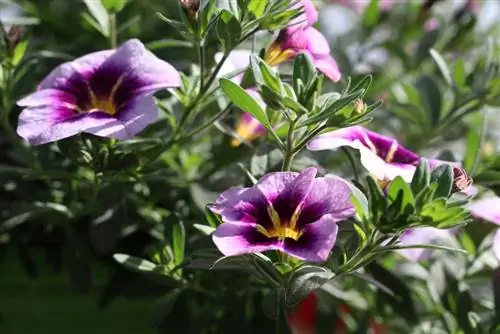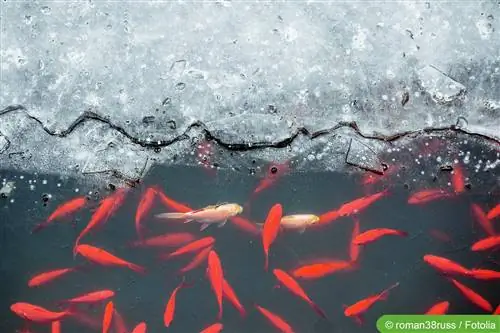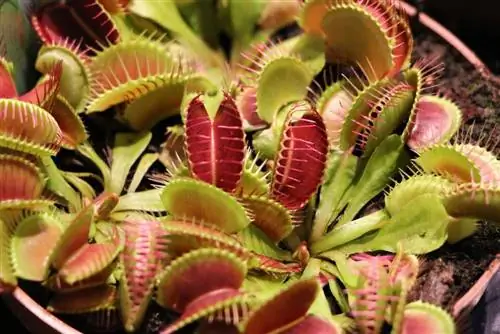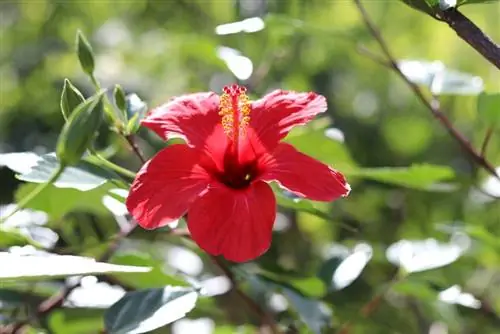- Author admin [email protected].
- Public 2023-12-17 03:39.
- Last modified 2025-01-24 12:45.
Petunias are native to South America and belong to the nightshade family. They shine with beautiful funnel-shaped flowers and a wide variety of species. Petunias come in different growth forms and also in different colors. The abundant flowering begins in July and ends with the first cold days. The plant is robust and adaptable. But petunias are not frost hardy, which is why they are treated as annual plants. Overwintering is still possible and with little effort, so you can enjoy the colorful plant for many years.
Overwintering the petunia
There are two ways to get petunias over the winter. One of these options is the seed. Obtaining this is very easy: wait until the flower is brown, then remove the cover and remove the seed capsule. It is important to make sure that the flower has already dried out a little. If you crumble them with your fingers, the petunia seeds will fall out. Dry these seeds and sow them in spring, around February/March. The seed needs a temperature of 20 degrees Celsius to germinate. Once the seedlings have reached an appropriate size, they can be planted in the balcony boxes. From around May onwards, with a bit of luck, the plants will bloom as beautifully as last year. The petunia can also be overwintered in its full bloom, although this is not recommended. The flower shoots should be cut off.
Tips for care and avoiding care mistakes
- Don't water too much, otherwise the roots of the petunias will rot and die.
- If the entire plant is overwintered, the flower shoots must be shortened, otherwise it will lose too much strength.
- Be sure to check for pests, otherwise there is a risk of uncontrolled spread.
- In winter there is no fertilization because the shoots shoot. But these are too weak because there is not enough light. In addition, fertilizing is responsible for harmful microorganisms, as the excess nutrients cannot be used by the plant.
- The wintering room should be light and cool
A bright location for the petunia to hibernate in the winter

Petunias can overwinter without any problems. The location is very important, as with all plants that overwinter. The flower lover usually goes and disposes of the plant after it has bloomed and buys new varieties again in the spring. But if you've stocked up on the rare varieties that you can buy in great color combinations and that aren't available everywhere, it's definitely worth bringing them over into spring. If you want to overwinter the petunia in all its splendor, the boxes should be put away before frost. The plants are examined for pests that can multiply quickly and uncontrollably in winter. The shoots are shortened to 15 to 20 cm. The advantage here is that you don't need as much space for the plants. The location should be bright. As a rule, petunias can continue to bloom throughout the winter, but this should be avoided. The plant uses too much energy, which can result in fewer flowers in spring. That's why the flower shoots are also cut off.
Care in winter quarters
When overwintering your petunias, you should pay attention to the correct amount of watering. The soil should not dry out, but should not be too moist either. The time to water is when the soil comes away from the edge of the pot. There is no fertilization during wintering. A good alternative is to work with the seeds of the plant. The seeds should be stored in a dark and dry place and should be sown in February. The germination temperature is 20° degrees. Light should also be present. Breeding from seeds is a little more work but is possible without any problems. After the Ice Saints, the plants can be placed at their destination. The size is then as big as the plants that are available to buy in stores.
Two options for wintering
There are two ways to overwinter petunias from a dead plant for the following year. One possibility is seeds. It's very easy to get them from dead plants: after a few days, when the flowers are no longer beautiful and turn brown, remove the sticky, faded cover from the petals and take out the small seed capsule. It should already be brown and slightly dry. If you twist it carefully between your fingers, it will open and the small petunia seeds will fall out.
They should be stored dark and dry at cool temperatures and can then be sown next spring - around February, but at the beginning of March at the latest. The petunia seeds need around 20 degrees Celsius to germinate. If the seedlings are large enough, they can be separated and planted in the balcony boxes. By May the petunias should bloom as beautifully as last year.
If you have the opportunity to overwinter the petunias in a bright place, you can also overwinter the plants completely. However, you should not forget to water moderately and ensure that the temperatures are always between five and ten degrees Celsius. With a bit of luck, some of the plants will even bloom through the winter. At the beginning of spring, some time before they are allowed back outdoors to their usual place, the mother plants are cut back well and the cut shoots are grown as seedlings.
Conclusion
The petunias are robust and have a variety of flowers and colors that is second to none. Overwintering is particularly worthwhile for the rare varieties of petunias, as this is possible without any problems. In addition, it has few demands on its winter quarters. The coming spring will reward you with plenty of flowers again. The petunias are, so to speak, thanking you for the little effort you put into overwintering.






